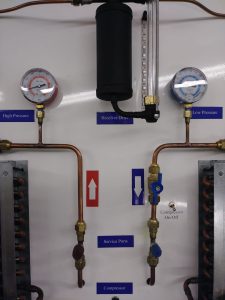From off-road mobile machinery markets to the automotive industry, the use of refrigerant in cooling systems have faced a continuous variation. The use of chlorofluorocarbon (CFC)-12, ozone-depleting refrigerant and air conditioning (MVAC) systems have been dismissed in modern motor vehicles in the mid-1990s. Hydrofluorocarbon (HFC)-134a or R134a has been one of the most commonly used refrigerants in MVAC systems since 1994. Notwithstanding, the governments of many countries have mandated emergency order for OEMs to strike R134a by the year 2021 as such refrigerants have severe global warming potentials (GWPs).
Why is R134a Harmful to Nature?
R134a is built on HFC models and HFCs are designedly-produced fluorinated greenhouse fumes. These gases are utilised in the motor vehicle air conditioning which is one of those applications where ozone-depleting materials are used. HFCs are dominant greenhouse gases with extremely severe global warming potentials (GWPs) that is 1,430 times that of carbon dioxide. The use of HFC-134a in MVAC systems is responsible for an approximated 24% of entire global HFC consumption. The government showed disapproval for using HFC-134a in brand-new light-duty vehicles. As per the federal order and for the sake of nature, numerous automobile manufacturers are adopting the transition to the latest, climate-friendly alternative refrigerants by replacing R134a with R1234YF.
Why is R1234YF a better alternative?
In automobiles and off-road products, manufacturers are shifting from R134A to R1234YF refrigerant. The auto enterprise has frequently experienced this transformation, and it further appears that the HFO 1234yf is pretty familiar to HFC 134a in performance but remarkably more suitable for the environment. That’s because R-1234YF is a hydrofluoric-olefin (HFO) while R-134a is a hydrofluorocarbon (HFC). Both HFO and HFC are formed of carbon atoms, hydrogen and fluorine. Nonetheless, there are striking variations between these two refrigerants as well in terms of Global Warming Potential. While R-134a has 1300 GWP, in the case of R-1234yf, it is 1-4. Again, R-1234yf is categorised as mildly flammable and interestingly it still has the feeblest flammability of any motor component-related fluid.
What are the benefits of switching to R1234YF?
- R-1234yf has the least GWP 1-4.
- R-1234yf is effectively adaptable to various usability conditions and it is suitable for installing in light-duty trucks and modern passenger cars
- Despite mild flammability, R-1234yf is safer than R-134a
Comparison Between R134a and R1234YF
The models of R134a and R1234YF are very identical. Nonetheless, R1234YF was designed with more environmentally friendly design to become the ideal replacement of R134a. In R1234YF, the air-conditioning system diagnosis can be performed in an equivalent technique as with R134a. Nevertheless, you will require diverse replacement devices and other tools to manage R1234YF. Some replacement devices are supplied for both R134a and R1234YF and these devices are implemented with intuitive refrigerant detection. To discard any kind of perplexity, ports for R1234YF arrangements come in various sizes.
The refrigeration cycles of the R134a and R1234YF are similar since the pressure /temperature similar relation of YF and R-134a as they both need SAE J2842 evaporator. Although the recovery and recycling procedures are more complex in the YF model, vehicles with R-1234yf have diverse service connections to prevent any possible cross-contamination. The sophisticated equipment of YF vehicles is certified by, and registered with, local EPA offices.
R1234YF- The Best Refrigerant for your Automobile
Most well-known auto manufacturers have already embraced R-1234yf in several models such as Tesla Model S, Chevrolet Spark EV, Dodge Challenger, Dodge Durango, Cadillac XTS, Range Rover and sport, Jeep Cherokee, Chrysler 200, Alfa Romeo 4C, Dodge Charger, BMW i3, and i8, Honda Fit EV, Ram 1500, Fiat 500 and 500L, Chrysler 300, Dodge Dart, Jeep and Wrangler. Although R-1234yf is costlier than R-134a, like most things, these costs will certainly drop as its demand becomes more general and production volumes increase.
It suggests that if you are thinking of replacing your R134a with R1234YF, always make sure to verify the OEM information and vehicle labels. Thus, you can ensure the ideal kind of refrigerant has been installed in your automotive. It is to be kept in mind that different models of refrigerants come with the requirement of different A/C tools, oils, and handling and storage needs. Also, make sure that your automotive engineers and technicians are seasoned with adequate training to effectively handle refrigerants you are expected to install. With the increase of automobiles with R1234YF, there are cost-effective trainers available to get technicians up to date on the learning of the R1234YF refrigerant and AC systems.
Read more about refrigerant trainers here.



